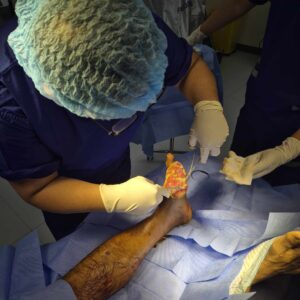Every step toward healing begins with understanding the challenges associated with toe ulcers and the specialized care they require. Toe ulcers can be a significant concern, particularly for individuals with underlying conditions such as diabetes. This article explores the comprehensive approach of orthopedic treatment for toe ulcers, detailing how expert care not only promotes healing but also protects mobility and prevents complications.
Understanding Toe Ulcers
Toe ulcers are open sores that typically form on the toes as a result of several underlying conditions. These lesions often develop due to poor circulation, nerve damage, or infection. In many cases, individuals with diabetes are more susceptible to developing toe ulcers because their bodies have a reduced ability to heal wounds and fight off infections.
What Are Toe Ulcers: Toe ulcers are areas of broken skin that can become deeply infected if not treated promptly. They are often a sign that there are more systemic issues at play, such as compromised blood flow or diabetic neuropathy (nerve damage caused by high blood sugar levels). When the integrity of the skin is compromised, the risk of bacteria entering the body increases, leading to potential infections that can be severe and even life-threatening.
Why Early Intervention Is Critical: The earlier toe ulcers are identified and treated, the better the outcomes. Early intervention can prevent the ulcer from worsening, reduce the risk of severe infection, and help maintain the function and mobility of the foot. Orthopedic treatment for toe ulcers focuses on addressing the root causes of the problem, promoting rapid healing, and preserving mobility through specialized interventions.
Common Causes and Risk Factors
Understanding the underlying factors that contribute to toe ulcer formation is crucial for both prevention and effective treatment. Several factors can increase the risk of developing toe ulcers:
Diabetes: Diabetes is one of the primary risk factors for toe ulcers. High blood sugar levels can lead to nerve damage (diabetic neuropathy) and poor circulation, both of which create a fertile environment for ulcers to develop. Diabetic patients often struggle with wound healing, making it essential to manage blood sugar levels and seek immediate orthopedic treatment for any foot injuries.
Poor Circulation: Compromised blood flow is another major contributor to the development of toe ulcers. Without adequate circulation, the skin and tissues do not receive enough oxygen and nutrients, which are vital for healing. Conditions such as peripheral arterial disease (PAD) further exacerbate the risk, making proper vascular care a critical component of treatment.
Nerve Damage: Nerve damage, or neuropathy, reduces the sensation in the feet. This diminished sensitivity means that minor injuries can go unnoticed, allowing small wounds to develop into more serious ulcers. Nerve damage is particularly common among people with diabetes and other chronic conditions.
Infection and Trauma: Even minor cuts or abrasions can lead to toe ulcers if they become infected, especially in individuals with compromised immune systems or poor circulation. Trauma, such as an injury from ill-fitting footwear, can also be a contributing factor.
The Orthopedic Approach to Treating Toe Ulcers
Orthopedic treatment for toe ulcers is a comprehensive and multidisciplinary approach that focuses on three main areas: controlling infection, promoting healing, and preserving mobility. By addressing each of these areas, orthopedic specialists can significantly improve patient outcomes.
A Holistic Treatment Method: Orthopedic treatment for toe ulcers involves more than just wound care. It is a holistic approach that considers the patient’s overall health, the specific nature of the ulcer, and any underlying conditions such as diabetes or peripheral arterial disease. This comprehensive strategy is designed to manage the immediate problem while also preventing future complications.
Three Core Focus Areas
Infection Control: Effective management of toe ulcers begins with controlling any present infection. Techniques such as debridement (removal of dead tissue), appropriate antibiotic therapy, and advanced wound care are critical in reducing the bacterial load and preventing the spread of infection.
Promoting Healing: Accelerating the healing process is a central goal of orthopedic treatment. This involves using both conventional and innovative methods, such as advanced wound dressings, hyperbaric oxygen therapy, and, in some cases, regenerative medicine techniques to stimulate tissue repair.
Mobility Preservation: Toe ulcers, if left untreated, can severely impair mobility and lead to long-term disability. Orthopedic treatment emphasizes the importance of maintaining foot functionality. This includes using custom orthotics, supportive footwear, and engaging in rehabilitation exercises to ensure that the patient’s mobility is preserved during and after treatment.
Key Components of Orthopedic Treatment
A closer look at the specific components of orthopedic treatment for toe ulcers reveals a detailed and patient-centered approach:
Infection Management
Debridement: Removing dead or infected tissue is essential to create an environment that supports healing. Debridement not only helps reduce the bacterial load but also stimulates the healing process by exposing healthy tissue.
Antibiotic Therapy: In cases where infection is evident, a tailored antibiotic regimen is initiated. This is often combined with local wound care techniques to ensure that the infection is controlled both systemically and at the site of the ulcer.
Advanced Wound Care: Utilizing modern wound dressings and technologies, such as antimicrobial dressings and moisture-retentive bandages, can accelerate healing and reduce the risk of infection.
Pain Management Strategies
Managing pain is crucial for patient comfort and recovery. Orthopedic specialists employ various interventions to alleviate pain associated with toe ulcers:
Medications: Pain relievers and anti-inflammatory medications are often prescribed to manage discomfort and reduce swelling.
Physical Therapy: Targeted physical therapy exercises help maintain circulation and support the overall healing process. They also play a key role in preserving mobility during the treatment phase.
Additional Interventions: Techniques such as nerve blocks or topical analgesics may be used in cases where pain is particularly severe.
Preserving Mobility
Maintaining the functionality of the affected foot is a priority during orthopedic treatment for toe ulcers:
Orthopedic Devices: Custom orthotics and specialized footwear are designed to offload pressure from the affected area, allowing the ulcer to heal without compromising the foot’s structure.
Rehabilitation Programs: Tailored rehabilitation exercises help restore strength and mobility, ensuring that patients can continue with daily activities while recovering.
Long-Term Benefits: The goal is not only to heal the ulcer but also to improve the patient’s overall quality of life by preserving mobility and reducing the likelihood of future complications.
Benefits of Seeking Orthopedic Treatment
Choosing orthopedic treatment for toe ulcers comes with a range of significant benefits:
Accelerated Healing: With a specialized treatment plan, patients often experience faster healing times. The comprehensive approach targets all aspects of the problem—controlling infection, promoting tissue repair, and preserving mobility.
Prevention of Complications: Early and effective treatment minimizes the risk of severe infections, tissue death, and even amputation. By addressing both the symptoms and the underlying causes, orthopedic treatment helps prevent the progression of the ulcer to a more dangerous state.
Enhanced Quality of Life: The ability to maintain mobility and manage pain effectively has a profound impact on a patient’s quality of life. Effective treatment ensures that patients can continue their daily activities with minimal interruption, which is essential for both physical and mental well-being.
Patient Success Stories: Many patients who have undergone orthopedic treatment for toe ulcers report significant improvements in their condition. Testimonials and case studies often highlight dramatic recoveries and renewed independence, which can inspire others to seek prompt medical attention.
When to Seek Professional Help
Recognizing the signs that indicate a need for professional care is crucial for preventing complications. Here are some key warning signs and guidelines:
Warning Signs
Persistent Pain or Swelling: If the pain in your toe or foot does not subside or if swelling worsens, it may be a sign of an underlying infection.
Changes in Skin Color or Temperature: Discoloration or a noticeable increase in warmth around the ulcer could indicate that an infection is developing.
Delayed Healing: Any wound that does not show signs of improvement within a week or two should be evaluated by a healthcare professional.
Self-Care vs. Professional Intervention: While minor cuts or abrasions can often be managed with proper self-care, toe ulcers require more specialized attention. If you notice any of the warning signs mentioned above, it is essential to seek orthopedic treatment for toe ulcers immediately. Early intervention is the key to preventing complications and ensuring a swift recovery.
Preventative Measures and Ongoing Care
Preventing toe ulcers from recurring is as important as treating them. A proactive approach to foot care can make a significant difference, especially for individuals with chronic conditions like diabetes.
Daily Foot Care Tips
Regular Inspections: Examine your feet daily for any cuts, blisters, or signs of irritation. Early detection can prevent minor issues from developing into ulcers.
Proper Hygiene: Keep your feet clean and dry. Regular washing and thorough drying, especially between the toes, can help prevent infections.
Suitable Footwear: Wear shoes that fit well and provide adequate support. Ill-fitting shoes can cause friction and lead to the formation of ulcers.
Lifestyle Changes
Managing Diabetes: For diabetic patients, maintaining proper blood sugar levels is critical. A balanced diet, regular exercise, and adherence to medication regimens are essential in preventing complications.
Regular Exercise: Engaging in regular physical activity improves circulation, which is vital for wound healing and overall foot health.
Regular Check-Ups: Routine visits to your healthcare provider can help monitor any changes in foot health. Early detection and treatment of any issues can prevent minor problems from evolving into serious conditions that require more intensive care.
Takeaway
Toe ulcers pose significant challenges, but with a comprehensive approach like orthopedic treatment for toe ulcers, healing and mobility preservation are well within reach. By focusing on infection control, pain management, and maintaining mobility, orthopedic specialists provide targeted care that addresses the root causes of the condition. Early intervention, coupled with ongoing preventative measures and lifestyle changes, can drastically reduce complications and enhance the quality of life for those affected.
If you experience any signs of toe ulcers or have concerns about your foot health, consulting with an orthopedic specialist should be your first step. The benefits of prompt and expert care extend beyond mere wound healing—they ensure that you can continue to enjoy an active, pain-free life. Remember, every journey to recovery starts with taking that first step toward professional help and committing to proper foot care.






